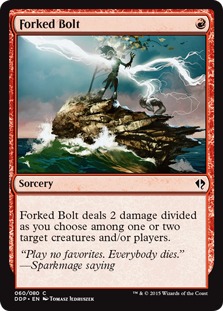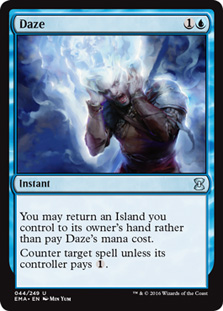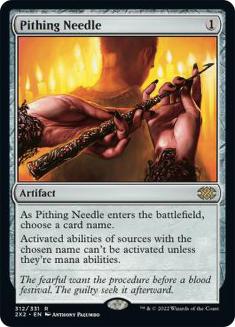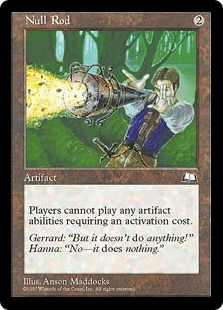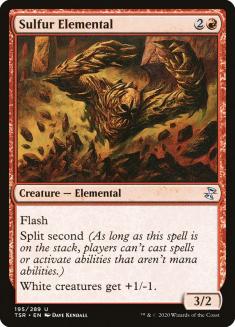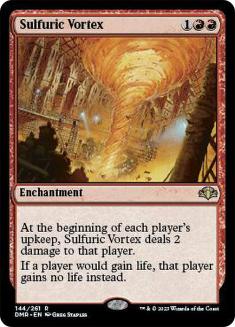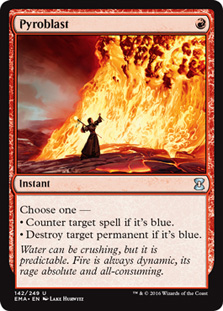This weekend is Grand Prix New Jersey, which is shaping up to be a truly colossal Legacy event. I’ve actually been playing a fair bit of post-Khans Legacy
lately and enjoying reasonable success. I won several local events, Top 4’d the Oakland Legacy Open, Top 4’d a solid Card Kingdom event, and have started to hit the local
events in Seattle at a run as well.
My advice is simple: Play Treasure Cruise, and you should probably play it in U/R Delver.
As I said in my post-Oakland article, I didn’t play very well in
that tournament. I don’t think I played poorly, but you can make a lot of small errors when you’re playing with Ancestral Recall and your opponents are
not. The card slots so well into existing decks that were already top strategies in the format that it makes essentially no sense to play anything else. No
non-Cruise decks improved as a result of its introduction into the format significantly enough to justify playing them.
So let’s talk about which one I’m playing.
Why Play U/R Delver?
Here’s the list I’d play in Grand Prix New Jersey.
Creatures (12)
Lands (16)
Spells (32)

If Vortex proves to be good against the “Gold Digger” style decks Carsten Kotter has been popularizing and that Rudy Briksza
recently won the Columbus Legacy Open with, I may trim back down to two Blood Moons and cut the maindeck Island for a fetchland again in order to fit the
second Vortex. I’ve already beaten that deck twice relatively convincingly, so I’m not really sold on it being that good.
I’ve got the cards to play any of the Cruise decks, but I’ve been sticking with U/R Delver and winning–a lot. My record with the deck is 31-4 (as best I
can recall) in events since I solidified my list and sideboarding, with losses coming to Goblins, Dredge, Mono-Red Sneak Attack, and Abzan. I can attribute
at least two of those match losses to errors in my play or deckbuilding, but even if that wasn’t the case I wouldn’t care at all, really. Not only am I
confident my deck is at least capable of beating them, even if it’s not a favorite, but they’re all such minor metagame players that I’m not really
concerned. Even if they’re beating me–frankly, a big if based on my experiences–they’re not objectively great decks in this metagame, at least not yet.
My list from the Oakland Legacy Open maindecked two copies of Pyroblast, a choice I didn’t regret and would happily make again. Why? Because if my opponent
isn’t playing blue, then they’re not playing Treasure Cruise, and I can afford to draw a blank once or twice… especially considering I’m already playing
Brainstorm to revitalize weak holdings. If they are playing Cruise, then I want something capable of tipping the balance in game 1 that remains relevant
after sideboarding–that’s Pyroblast.
This exact impulse is likely what has led the charge into Jeskai Delver and rebuilding Temur Delver and Sultai Delver. Those pilots think Stoneforge Mystic
or Tarmogoyf or Deathrite Shaman give them an edge in Treasure Cruise mirrors, and they’re right–sort of. They give them an edge in game 1. Unfortunately,
we play more sideboarded games than game 1s, and not only are all of these cards worse after sideboarding… in my experience, the tradeoffs are actually a
major liability.
Let’s address them one by one.
In game 1, a Stoneforge Mystic on the stack means I’ve either got to be able to burn it out after resolving or keep it from entering the battlefield. Why?
Because getting a Batterskull onto the battlefield is usually enough to win the game. It won’t always kill me, but the resource exchange required is on par
with letting the opponent resolve a Cruise–it will cost me too much to fight afterward, so I need to be able to fight now. This is good for the Jeskai
Delver player, as they can curve out with Delver to soak removal and make Mystic tougher to beat, freeing up their ability to resolve Cruise in the later
turns. Naturally, having True-Name Nemesis as a Bolt-proof Jitte Wielder is also handy.
After sideboarding, this dynamic reverses completely. Suddenly, I have whatever Shatter I’m playing to handle the best cards in their deck, which means the
only cards in their deck commonly capable of killing me are going to be unchecked Delvers (lol) or resolved Treasure Cruises, as racing a lonesome Nemesis
is easy. However, it gets even worse for them because I’m now also accessing Blood Moon, which will lock them out of even playing Magic if it resolves
unchecked. This forces them to dilute their deck with Wear//Tear and hold open a white mana in fear for the vast majority of the game.
Suddenly, I’m the player with multiple cards that must be answered, putting me right in the driver’s seat.
Tarmogoyf has been a thorn in U/R Delver’s side for years. It’s big enough to survive burn spells and fast enough to race you if you fall behind. However,
U/R has gained weapons over the years, while Temur Delver has been forced to trim Nimble Mongoose and lost a lot of ground as a result. Young Pyromancer is
capable of stalemating the big man, and Monastery Swiftspear can sometimes muster the power to run past it, and at a minimum, offers you opportunities to
take a two-for-one and get him off the battlefield.
Funny thing about two-for-ones? They don’t matter as long as you can Cruise. Another trick afforded to you by Treasure Cruise is Bolting Tarmogoyf and then
delving away your graveyard; as long as the opponent only has two types of cards in his, this will kill the Tarmogoyf without offering the opponent an
opportunity to save it. They have to act in response to the Lightning Bolt, which gives you the opening you need to resolve the Cruise in the first place.
Tarmogoyf is essentially a more difficult to answer Stoneforge Mystic that is much less powerful in actual practice. As such, Temur and Sultai Delver decks
are often vulnerable in the same way. After sideboarding, access to Blood Moon is incredibly potent and completely changes how your opponent must play the
game.
This card is just not that good.
Every U/R Delver deck has six mana-efficient ways to answer it, and the typical “powerhouse” spells that Shaman has been casting for the past three years
are all much, much worse. Liliana of the Veil is at an all-time low, Rest in Peace is gaining ground in sideboards whether it should or not, and most of
the ways people are trying to hate on U/R Delver (such as Pyroclasm) are going to splash up on you.
Killing Deathrite Shaman is important for U/R Delver, sure. But if it goes live for a couple turns, it’s hardly the end of the world. No deck in the format
is better at finding a Lightning Bolt in a tough spot than U/R Delver! After sideboarding, your Blood Moons are still good because burning down Shamans was
already part of the plan.
You’ll note that I placed a big emphasis on games after sideboarding above. Not only do they matter more, but they’re where I’ve been most successful. I’d
guess I’m batting slightly over 60% in game 1s right now, though I don’t have the actual data, but when you contrast that with my 88% of matches won it’s
easy to see the discrepancy comes from my tactics after sideboarding. Those games are where I’ve done most of my winning, and I’d like to let you guys in
on some of the tricks.
Play High-Impact Sideboard Cards
These Grim Lavamancers and Spell Pierces and Flusterstorms have got to go! These cards are trash. Legacy was a nuanced world where this kind of flexibility
was valuable a few months ago, but this is a world where Ancestral Recalls lurk behind every draw step. You’re not going to beat anyone with these softies.
Look at my most recent sideboard:
1 Cursed Totem
2 Grafdigger’s Cage
1 Null Rod
2 Pithing Needle
2 Sulfur Elemental
3 Blood Moon
1 Sulfuric Vortex
1 Pyroblast
2 Smash to Smithereens
I’m currently favoring Smash to Smithereens over Smelt due to an expected uptick in Chalice of the Void decks and a downward trend in Spell Pierces, but
I’ve also been experimenting with playing a Tropical Island and Ancient Grudges. I’m not really sure which is better as of now, but the metagame could
certainly twist in such a way as to make Grudge the superior option, even given how often Moon and Smash come in together.
I’ve already talked a big game about Blood Moon, and I think we all understand its power level. However, my sideboard is essentially packed with
pseudo-Moons, in that my opponents won’t often be able to win if the card is in play.
Null Rod is a supplementary Pithing Needle against Miracles and also works some magic against these new Stoneforge Mystic decks with Engineered Explosives.
Its power level against any Aether Vial deck is obvious, especially Death and Taxes which is hard-pressed to ever win a game with the Rod in play. But my
primary plan for Death and Taxes lays in the Cursed Totem and Sulfur Elemental plan, of course.
In game 1, a turn 1 Mother of Runes merits an immediate burn spell, freeing them up to deploy Thalia or Spirit of the Labyrinth with a chance of it
surviving. This is a reasonable edge, and the matchup is often very race-like–much like Jeskai Delver, I must try to end them before they can assemble an
unbeatable combination. Just like Jeskai Delver, that flips backwards after sideboarding. With three cards that not only answer Mother of Runes but blank
future Mothers and other cards at the same time, I get to conserve my removal for creatures that actually matter. Turn 1 Mom into turn 2 Thalia is huge in
game 1, but after sideboarding can lead to hilariously simple wins. And of course, the equipment also once more goes from game-breaking to answerable, and
I’m a sizable favorite in the matchup.
This is essentially how I’ve built my sideboard to handle every matchup–profitably neutralize whichever cards grant them initiative or inevitability, and
then center all of my efforts on fighting counter-wars over those powerful permanents or Treasure Cruises.
Stop Always Cutting Force of Wills
Previously, it was common practice to lose some number of Force of Wills in attrition matchups and mirrors because the two-for-one was too costly to bear.
Treasure Cruise has changed everything, however, because resolving one or two copies of it will often win the game regardless of how many times you had to
Force. What’s more, I’ve structured my sideboard to make very few cards “matter” so that I can afford to fight over the ones that do more aggressively.
Force is key if that’s your tactic, as it’s the only hard counter that works against everyone.
I’m not saying never sideboard it out, but it should no longer be where you reach first, and you rarely want to cut all of them.
Don’t Cast Gitaxian Probe on Turn 1
This goes for game 1 as well, but after sideboarding, it’s very rare that you should do this. Not only will it be one of your less potent blue cards for
Force of Will pitches, but the information becomes more and more valuable once you progress into the midgame. The first few turns are almost always spent
making or accepting trades; I don’t fight over much before turn 3 unless I’m Dazing for profit. However, knowing if the coast is clear for a resolved Blood
Moon is huge and the same goes for figuring out when you can safely Cruise. That’s before we even go into forcing Swiftspear past blockers and making
tokens with Pyromancer.
Generally speaking, the only time I Probe on turn 1 is if I have to decide between a basic and a dual off a single fetchland and need to spot-check for
Wasteland.
Miracles is a Good Matchup
All of these internet jokers saying “Cruise doesn’t matter, I just Counterbalance everything!” are out of their gourds. I think–think–game 1
might be bad for U/R Delver, though it’s mostly going to be play/draw dependent, but I’ve been annihilating this deck over and over in sideboarding and
remain completely confused as to how they’ll stop me.
Generally, here’s my plan:
Out:
In:
The split on Bolt and Daze varies depending on the play or the draw and their precise decklist and play style. Depending upon those factors, I sometimes
bring in the Blood Moons as well, siding out additional Bolts and Dazes. I’ve noticed it’s surprisingly common for Miracles players to “assume” I won’t
Moon them because they can play around it, only for that knowledge to convince them they shouldn’t play around it all!
The Elementals might seem odd, but my plan is to overload their removal while turning off Top. This means they have to generally use their draw step to
Terminus, making an uncounterable flash creature a better threat than it might otherwise seem. Also keep in mind that Terminus doesn’t actually kill your
creatures–conserving a fetch to shuffle the bottom of your deck back into the mix makes a difference.
Could I be wrong about the matchup? I suppose, but until I actually lose to it I’m fine with my approach.
If You Play Burn, Play Burn
I’ve seen so many lists sideboarding Price of Progress and Blood Moon together, and that’s just nonsensical. Sideboarding a super-charged Flame Rift is
slightly questionable in general, but sideboarding both is downright silly. Similarly, I can respect the impulse to run Wasteland in an aggressive tempo
deck with Dazes… but if you do that, cut the Blood Moons! You can’t leverage the whammy of a Blood Moon against opponents while simultaneously playing with
multiple other cards that encourage them to prioritize basics.
Clearly, I prefer Blood Moon–it’s been incredible for me, and until people start truly respecting it I’m sticking by it. However, I fully respect that the
burn option is powerful and another way to build and play the deck. All I ask is that you commit to it: play Chained Lightning over Forked Bolt, access
Price of Progress, have a Fireblast or two! A schizophrenic approach to Burn has never worked out, but if you focus in on it, then you’ve got some
potential there.
If you’d like a deck that rewards average play with easy wins, my version of U/R Delver has been working some serious overtime for me, and it might just be
able to do the same for you.
Good luck to everyone playing in Grand Prix New Jersey!





